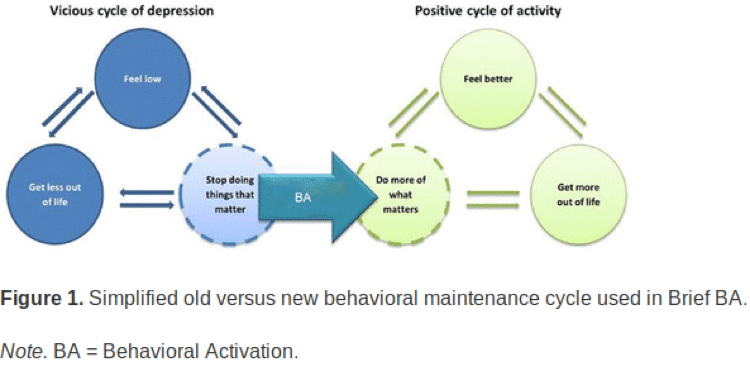Behavioral Activation Therapy: 14+ Techniques & Worksheets
 Behavioral activation (BA) is a therapeutic intervention that is often used to treat depression.
Behavioral activation (BA) is a therapeutic intervention that is often used to treat depression.
Behavioral activation stems from a behavioral model of depression that conceptualizes depression as a consequence of a lack of positive reinforcement. BA is highly customizable and is a very personal treatment plan.
This article will cover what BA is, the behavioral model it is based on, and how to implement BA as a treatment plan, including some of the techniques used in Behavioral Activation.
Before you continue, we thought you might like to download our three Positive CBT Exercises for free. These science-based exercises will provide you with detailed insight into Positive CBT and give you the tools to apply it in your therapy or coaching.
This Article Contains:
- What is Behavioral Activation (BA) And How Is It Used To Treat Depression?
- Behaviorism: The Behaviorist Theory Behind BA
- Applied Behavior Analysis: Can ABA Help Your Client?
- The Use Of A Behavioral Model For Behavioral Activation
- 10+ Techniques For Behavioral Activation
- 4+ Behavioral Activation Worksheets & Activities
- A Take-Home Message
- References
What is Behavioral Activation (BA) And How Is It Used To Treat Depression?
Behavioral activation (BA) is “a structured, brief psychotherapeutic approach that aims to (a) increase engagement in adaptive activities (which often are those associated with the experience of pleasure or mastery), (b) decrease engagement in activities that maintain depression or increase risk for depression, and (c) solve problems that limit access to reward or that maintain or increase aversive control” (Dimidjian et al., 2011).
The main idea behind BA as a treatment for depression is “to allow patients with depressive symptoms to learn to cope with their negativity” and to “increase positive awareness through the re-development of personal goals in the form of short, medium and long-term life goals” (Chan et al., 2017).
In other words, BA is a type of therapeutic intervention (most often used to treat depression) that focuses on behavioral changes in a client’s daily life. BA interventions might involve helping the client plan more activities they actually enjoy doing, helping the client develop their social skills, or just generally having the client track their own emotions and activities.
Behavioral Activation is a highly-personalized intervention that targets one’s depression by targeting the behaviors that feed into that depression.
Behaviorism: The Behaviorist Theory Behind BA
Behavioral activation is informed by a behavioral model of depression, such as the one outlined by Lewinsohn & Shaffer (1971).
These researchers believed that depression was a behavioral issue (as opposed to a cognitive issue) that arose from a lack of positive reinforcement, particularly in social relationships.
Since they subscribed to a behavioral model of depression, the authors believed that the best way to treat depression was to “restore an adequate schedule of positive reinforcement for the individual by changing the patient’s behavior and/or the environment”.
While some psychologists still subscribe to radical behaviorism, most modern behavioral models are not exclusively behaviorist and do include cognitive components.
Most modern psychological models, in general, include both cognitive and behavioral aspects, exemplified by cognitive-behavioral therapy (CBT), perhaps the most common therapeutic treatment today. In fact, behavioral activation has begun to be explored as a component of CBT for disorders beyond depression, such as anxiety (Boswell et al., 2017).
Interestingly, behavioral activation may even be the driving force behind the efficacy of CBT. A study by Jacobson et al. (1996) which found that to be the case is one of the main reasons people are interested in Behavioral Activation today. Specifically, those researchers found that people with depression who completed BA saw as many benefits as people with depression who completed both BA and some cognitive components of CBT.
While behaviorists no longer deny the importance of cognition, they still advocate for behavioral treatments over cognitive treatments, since behaviors are easy to target than thoughts.
The paper cited above (Jacobson et al., 1996) indicates that behavioral activation may even be the reason CBT is so effective.
Thus, while behaviorists no longer necessarily think that positive reinforcement is the only way to treat depression, they still believe it is one of the best ways.
Applied Behavior Analysis: Can ABA Help Your Client?
Behavioral activation is a type of applied behavior analysis, which is a field of research based on the principles of B.F. Skinner’s work, and particularly his findings that “in a given environmental context, behaviors that produce favorable outcomes will continue to occur through the process of reinforcement and those behaviors that do not produce favorable consequences will decrease over time, or extinguish” (Roane et al., 2016).
One of the strengths of behavioral activation is that it can be customized according to a person’s “values and abilities”, and can also be customized for specific types of MDD, such as comorbid MDD and a personality disorder (Cannity & Hopko, 2017; Kanter et al., 2010). In other words, in almost all cases of depression, some sort of BA intervention is appropriate.
One thing to keep in mind about BA interventions is that the therapist must be mindful of their own reinforcement of the client’s behaviors (Pass et al, 2016). That is, the therapist should make sure to reinforce healthy behavior from their client during their sessions.
What is behavioural activation (BA)? – Psychological therapy for depression explainer – Cochrane Mental Health
The Use Of A Behavioral Model For Behavioral Activation
In order to develop a behavioral activation intervention for a client, one must first conceptualize a behavioral model of that client’s depression.
Take the case study of a 16-year-old girl named Amy with depression (Pass et al., 2016). In order to begin treating her depression, her therapist interviewed both Amy and her mother in order to figure out what her depression looked like.
From their input, the therapist determined that Amy’s depressive symptoms likely stemmed from her father’s recent death, her mother’s recent illness, her symptoms of fatigue, and her increased academic workload. Her fatigue was of particular interest, as it kept her from positive reinforcement, particularly in her social life.
That is, since she felt tired, she would not go hang out with her friends. Since she was not hanging out with her friends, she would feel bad, and this bad feeling would lead her to have low energy levels. This “vicious” cycle is presented here (reprinted from the article), along with an alternative cycle which Behavioral Activation interventions aim to put in place:
BA was ultimately able to help Amy get over her feelings of depression, in part by helping her find more positive reinforcement in her social life. The personalized behavioral model of Amy’s depression conceptualized by Amy, her mom, and her therapist was a crucial aspect of this improvement.
The benefits of a behavioral approach (as opposed to a cognitive approach) like this are illustrated by a comment from Amy, as the paper notes that “Amy had stated in her assessment that she wanted something more ‘practical’ than the bereavement counseling she had received previously. She felt that she had already had an opportunity to explore her feelings toward her father’s death, and this was not her aim for the current work”.
10+ Techniques For Behavioral Activation
Some of the techniques used in behavioral activation include (Dimidjian et al., 2011; Lejuez et al., 2001a):
- Self-monitoring of activities and mood
- Activity scheduling
- Activity structuring
- Problem-solving
- Social skill training
- Hierarchy construction (ranking how easy certain activities are to accomplish)
- Shaping (training healthy behaviors)
- Reward
- Persuasion
- Behavior contract (signing a contract with friends and family so that they will only reinforce healthy behaviors)
- Life area assessment (determining in which areas of life one desire success)
More information on some of these techniques can be seen in A Brief Behavioral Activation Treatment for Depression Treatment Manual (Lejuez et al., 2001a), listed at the end of the following section.
4+ Behavioral Activation Worksheets & Activities

Positive Activities for Behavioral Activation
This worksheet will help someone figure out some of the activities that they find rewarding, and how rewarding they find those activities. The worksheet simply asks for a list of activities, then asks how rewarding each of those activities is. This worksheet is a good way for someone to figure out which activities they actually find rewarding in life.
Behavioral Activation Worksheet Fun & Achievement
This is a basic activity scheduling worksheet. Activity scheduling helps people follow through on their responsibilities, but also helps people plan more positively-reinforcing activities (such as spending time with friends). As the worksheet states, the best effects are achieved by scheduling a balance of responsibilities and fun activities.
Behavioral Strategies for Managing Depression
The above worksheet is part of a larger packet, and this is that larger packet. Aside from the activity scheduling worksheet, it also includes a more rigid activity schedule that can help someone plan out their days, rather than just plan a few activities for the near future.
Besides those two worksheets, this packet also includes information on how behavioral techniques can help depression, and how one can use these behavioral techniques to their advantage. This is a deep resource that can help someone both understand why BA is helpful and start practicing it in their lives.
A Brief Behavioral Activation Treatment for Depression Treatment Manual
Finally, this is an entire treatment manual for a brief behavioral activation treatment for depression (BATD), as outlined by Lejuez et al. (2001b).
It can “be used as a complete treatment, or as a component of therapy that may include other therapeutic techniques and possibly medications”. It includes a discussion of BA and BATD as well as justifications for these treatments and also includes worksheets and other resources to help someone follow a BA program.
This manual is deep and will take a while to work through but is likely the most complete resource available for someone interested in Behavioral Activation.
A Take-Home Message
Ever since Jacobson et al. (1996) claimed that behavioral activation was the most effective component of CBT, Behavioral Activation has been a treatment of interest for depression. Several papers have since found that BA is indeed an effective way to treat depression, even when that depression is comorbid with another disorder.
There is no doubt that BA is an effective way to treat depression, but BA carries with it a unique implication.
A key aspect of Behavioral Activation is positive reinforcement, particularly in social situations. This means that how we respond to the people with depression around us can have major impacts on their mood in the short-term and their health in the long-term.
While we all have plenty of things on our mind at all times, we should also keep in mind how we are responding to the healthy and unhealthy behaviors of the ones we love. Reinforcing the healthy behaviors of a friend may just be the key to their recovery from disorders like depression.
We hope you enjoyed reading this article. For more information, don’t forget to download our three Positive CBT Exercises for free.
- Boswell, J.F., Iles, B.R., Gallagher, M.W., Farchione, T.J. (2017). Behavioral Activation Strategies in Cognitive-Behavioral Therapy for Anxiety Disorders. Psychotherapy, 54(3), 231-236.
- Cannity, K.M., Hopko, D.R. (2017). Behavioral Activation for a Breast Cancer Patient with Major Depression and Coexistent Personality Disorder. Journal of Contemporary Psychotherapy, 47(4), 201-210.
- Chan, A.T.Y., Sun, G.Y.Y., Tam, W.W.S., Tsoi, K.K.F., Wong, S.Y.S. (2017). The effectiveness of group-based behavioral activation in the treatment of depression: An updated meta-analysis of randomized controlled trial. Journal of Affective Disorders, 208(1), 345-354.
- Cuijpers, P., van Straten, A., Warmerdam, L. (2007). Behavioral activation treatments of depression: A meta-analysis. Clinical Psychology Review, 27(3), 318-326.
- Dimidjian, S., Barrera, M., Martell, C., Muñoz, R.F., Lewinsohn, P.M. (2011). The Origins and Current Status of Behavioral Activation Treatments for Depression. Annual Review of Clinical Psychology, 7(1), 1-38.
- Jacobson, N.S., Dobson, K.S., Truax, P.A., Addis, M.E., Koerner, K., Gollan, J.K., Gortner, E., Prince, S.E. (1996). A component analysis of cognitive-behavioral treatment for depression. Journal of Consulting and Clinical Psychology, 64(2), 295-304.
- Kanter, J.W., Manos, R.C., Bowe, W.M., Baruch, D.E., Busch, A.M., Rusch, L.C. (2010). What is behavioral activation?: A review of the empirical literature. Clinical Psychology Review, 30(6), 608-620.
- Lejuez, C.W., Hopko, D.R., Hopko, S.D. (2001a). A Brief Behavioral Activation Treatment for Depression. Behavior Modification, 25(2), 255-286.
- Lejuez, C.W., Hopko, D.R., LePage, J.P., Hopko, S.D., McNeil, D.W. (2001b). A brief behavioral activation treatment for depression. Cognitive and Behavioral Practice, 8(1), 164-175.
- Lewinsohn, P.M., Shaffer, M. (1971). Use of home observations as integral part of treatment of depression – preliminary report and case studies. Journal of Consulting and Clinical Psychology, 37(1), 87-94.
- Pass, L., Whitney, H., Reynolds, S. (2016). Brief Behavioral Activation for Adolescent Depression: Working With Complexity and Risk. Clinical Case Studies, 15(5), 360-375.
- Roane, H.S., Fisher, W.W., Carr, J.E. (2016). Applied Behavior Analysis as Treatment for Autism Spectrum Disorder. Journal of Pediatrics, 175(1), 27-32.
Let us know your thoughts
Read other articles by their category
- Body & Brain (49)
- Coaching & Application (57)
- Compassion (26)
- Counseling (51)
- Emotional Intelligence (24)
- Gratitude (18)
- Grief & Bereavement (21)
- Happiness & SWB (40)
- Meaning & Values (26)
- Meditation (20)
- Mindfulness (45)
- Motivation & Goals (45)
- Optimism & Mindset (34)
- Positive CBT (28)
- Positive Communication (20)
- Positive Education (47)
- Positive Emotions (32)
- Positive Leadership (18)
- Positive Parenting (4)
- Positive Psychology (33)
- Positive Workplace (37)
- Productivity (16)
- Relationships (46)
- Resilience & Coping (36)
- Self Awareness (21)
- Self Esteem (37)
- Strengths & Virtues (31)
- Stress & Burnout Prevention (34)
- Theory & Books (46)
- Therapy Exercises (37)
- Types of Therapy (64)







What our readers think
The ideas presented here have metaphorically helped my eyes to focus on the shape of the next stepping stone I need to progress out of my depression; essentially encouraging me to “activate” through decisive scheduling, the knowledge I have gained from the study of CBT ( but wasn’t sure how to connect the dots.) This publication of Joaquin Selva Bc.S.’s research has served as a tutor to explain to me in practical terms, ways that I can bennefit from CBT through the practice of BADT: as if I am now sitting at a game table with those I love and Joaquin has helped deal me in and given me enough information that I can partipate. I am already using some of the suggestions and revisiting the artical to reinforce my practice. It struck me as unique to this set of information – how the patient is encouraged to interact with their significant others in a supportive team effort. For some reason I had percieved CBT to be a bit more isolating, like “You’ve got to think through your depression, and only you can think your issues through for yourself. Becaause you have no control over others, you and your therapist can only work on you.” (I dont mean to reflect poorly on CBT – which has been groundbreaking work for me; only to reflect my personal understanding of my CBT experience which felt like hard work I was meant to do on my own. Perhaps why the concepts of BA ring so truly in me is due to the work I have already completed in CBT. )
what are the limitations and strengths to this approach
I can see one significant limitation to this: in severe long-term depression there may in fact be nothing that a person finds pleasurable and/or knows they enjoy, which would make the mentioned activities harder to complete. There may also be no social network for them to lean on, meaning they will have to rely on strangers for positive reinforcement, and as we all know that’s very difficult to get in this world.
Hi Leigh,
Thank you for taking the time to share your thoughts on the article! Your observations regarding the challenges faced by individuals with severe long-term depression are important considerations.
We understand that for some people, identifying pleasurable activities or having a supportive social network may not be feasible, and this could pose difficulties in implementing behavioral activation therapy as described in the article. It’s crucial to acknowledge these limitations and explore alternative approaches that may be more suitable for individuals in these circumstances.
We will consider creating additional resources that delve into alternative therapeutic approaches for individuals with severe long-term depression who may require more specialized interventions.
Thank you again for your valuable feedback, and please don’t hesitate to reach out if you have any further suggestions or concerns.
Kind regards,
Julia | Community Manager
Studying Counselling psychology, this article was helpful to me to understand the subject
Hi,
I found this article very helpfull as a therapist using CBT treatment. However, 2 of the links for the worksheets did not work, and I was forwarded to a 404 error page? I hope, I can get a chance to download, and implement, your exercises. Fingers crossed.
Best Regards,
Inge
I had the same issue accessing the worksheets – if you go to the same web page and search ‘behavioural activation worksheets’ they come up 🙂
Hi Anna and Inge,
Thanks for spotting these broken links. We’ll get these corrected very soon. But in the meantime, you can find the third worksheet here, and the fourth larger activity packet here.
– Nicole | Community Manager
Thank you very much!
Thanks for your information.
Thia was a very useful read !!
Very impacting,Iam using it for my thesis,thanks.